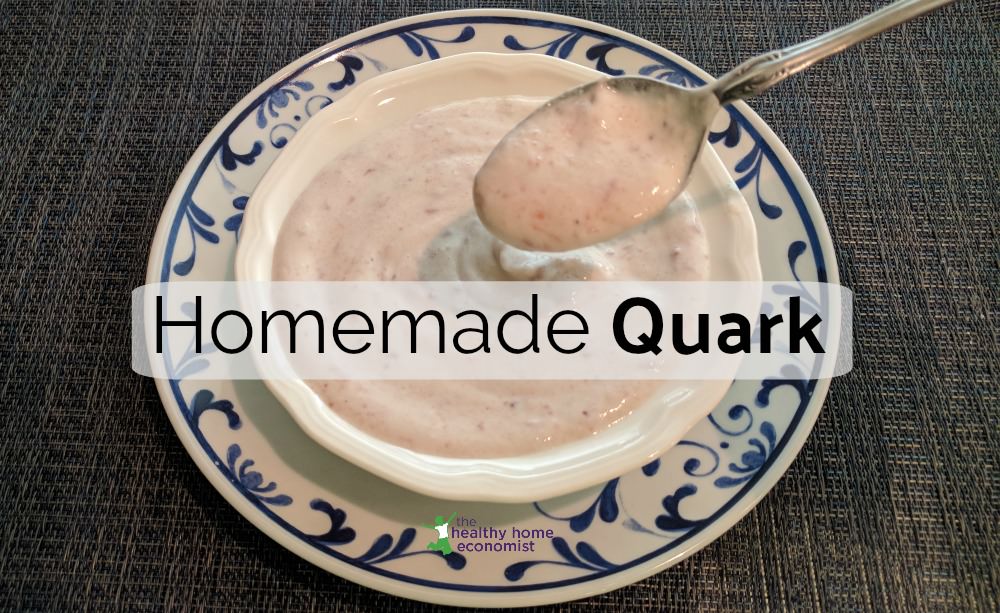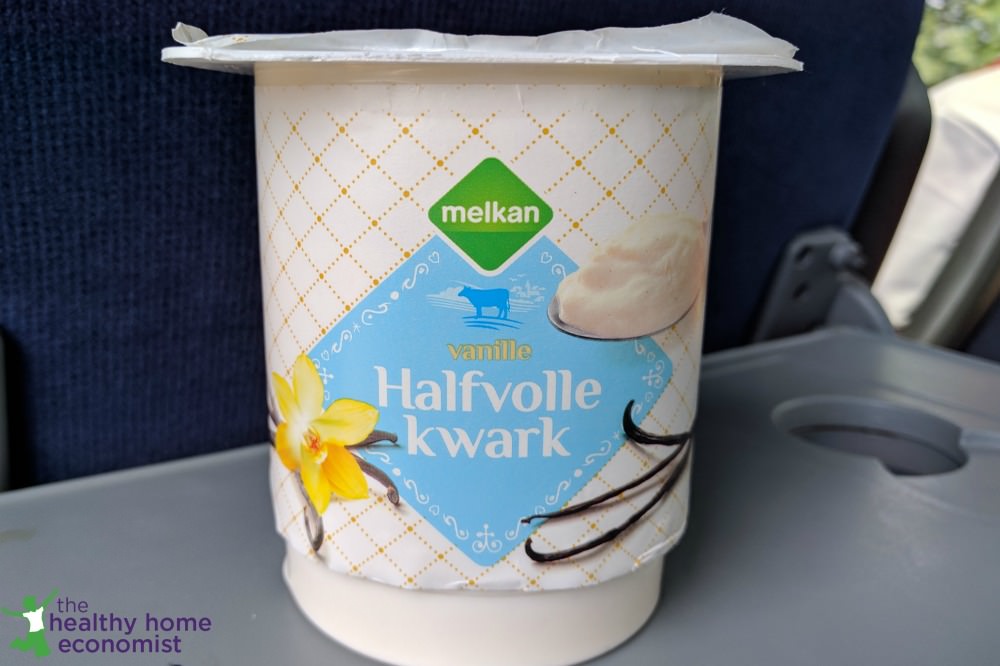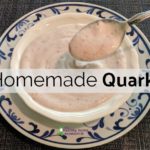Table of Contents[Hide][Show]
 I first tasted quark in the Netherlands (kwark) while on a summer trip with one of my children’s sports teams. I saw it everywhere in both supermarkets and tiny health shops (natuurwinkel) not only in Dutch villages, but also in more urbanized areas of Germany and Belgium. Having never tried it before, I curiously bought some and instantly fell in love with this German style dairy food.
I first tasted quark in the Netherlands (kwark) while on a summer trip with one of my children’s sports teams. I saw it everywhere in both supermarkets and tiny health shops (natuurwinkel) not only in Dutch villages, but also in more urbanized areas of Germany and Belgium. Having never tried it before, I curiously bought some and instantly fell in love with this German style dairy food.
Reminiscent of Greek yogurt with its thick, spoonable texture, quark is milder in flavor like a fresh, soft cheese. Some liken it to a cross between cottage cheese and yogurt.
However, I think a blend of ricotta cheese and Greek yogurt is a more fitting description of quark’s uniquely smooth texture and mildly sweet taste.
What is Quark?
Some say quark is more like yogurt. Others say it is a cheese. While both are accurate from a visual and taste point of view, technically quark is a fresh, unaged soft cheese.
Quark is a high fat, protein rich food with few carbohydrates. Thus, it is acceptable for those on a ketogenic diet or who prefer low carb foods in general.
Fake Quark
Many modern recipes call for using rennet when making quark. Watch out for commercialized versions in the United States that use nonfat milk and/or vegetable rennet (“enzymes”) of likely GMO origin.
This politically correct approach is not traditional at all! Other recipes suggest using lemon juice to sour and curdle the pasteurized milk quickly. Translation: before it rots and goes putrid!
This is not how traditional quark is made either. Consider that traditional peoples who invented and enjoyed quark cheese didn’t even drink pasteurized milk!
As you can see, modern methods for making quark have unfortunately adapted to the processed dairy most people are accustomed to using.
Traditional Quark
Historically, quark was made using fresh cow milk (i.e., raw) and small amounts of cultured buttermilk. Some areas of Eastern European origin may have used kefir or clabber as the inoculant to slowly and naturally curdle the milk.
Artisans did not generally use goat milk. However, if this is the only fresh milk you have available, that is fine too.
If you’ve ever made homemade cream cheese or raw sour cream, the process of making quark is very similar and just as easy.
Below is the last container of Dutch kwark that I enjoyed as a snack on the flight home from Amsterdam. Needless to say, learning to make homemade quark became a priority!

How to Make Quark
The quark recipe below uses raw grassfed milk. If you do not have access to fresh dairy where you live, you may substitute low temp pasteurized, nonhomogenized milk.
Do not use pasteurized, homogenized milk even if it is organic. This milk is too denatured, allergenic and overly processed to serve as the basis for a healthy, traditional recipe.
How to Enjoy Quark Cheese
Because traditionally made quark is probiotic rich, it is best not to use it in cooked recipes. It works very well as a base for your favorite dip recipes served with veggies or crackers. For sweet recipes, try using it make no bake cheesecake instead of yucky commercial cream cheese.
Since the consistency is similar to yogurt, smoothies made with quark work very well too. Blend in a few berries, and it is a delicious spread for bagels much like cream cheese. If homemade cream cheese is too strong tasting for your family, quark is a much milder option.
I like to scoop some into a bowl and stir in my favorite sugar free jam (sweetened only with fruit) as pictured above. It is just like yogurt only more mellow in flavor.
If you have a creative way you are using quark in your home, please share it with us!

Traditional Homemade Quark Recipe
Recipe for traditional quark that is a delicious spoonable cheese similar in texture to Greek yogurt, but milder in flavor similar to ricotta.
Ingredients
- 1 quart whole milk nonhomogenized and preferably raw
- 1 cup cultured buttermilk
- 1 Tbl 100% fruit jam
Instructions
-
Heat the milk to 115°F/ 46°C in a medium sized pot on the stovetop. Do not exceed 117°F/ 47°C or the probiotics and enzymes will be lost.
-
Pour the warm milk into a glass bowl or large mason jar. Stir in the cultured buttermilk that is at room temperature. You can use it cold right out of the fridge, but this may inhibit the setting of the quark.
-
Cover the bowl or jar with a small, clean dishtowel.
-
Leave the glass container in a warm place for 12-24 hours. If your home is cool, placing the bowl on the warming zone on the stove set to low for a few hours (and then turned off) works very well. Do not use a cooking burner! Other ideas include placing the bowl in the oven with the pilot light on or a microwave or convection oven with the door closed and the light on. If your oven has a warming drawer, this is a good place to use as well.
-
Once the quark is slightly thickened and set, drain the whey by using one of three methods. Pour the quark into a bowl lined with a large flour sack cloth or doubled, fine mesh cheesecloth. Gather up the ends, tie with a large rubber band and hang from the knob of an upper cabinet. Keep the bowl underneath to catch the dripping whey. Alternatively, tie up the ends of the towel and fasten to the sink spigot or a large mixing spoon suspended on the sides of the bowl underneath.
-
Drain for two hours. If you drain too much whey and the quark is too thick, simply mix some back in until you achieve the consistency of Greek yogurt.
-
Refrigerate quark in a jar or bowl with a sealed lid. Enjoy alone with 1 Tbl fruit jam stirred into 8 ounces or blended into smoothies, dips or spreads. It is a wonderful change from yogurt and kefir!
Recipe Notes
If your quark has not set within 24 hours, leave it for an additional 12 hours. If it still has not set, the mixture likely was too cool for the culture to take. This has not happened to me, but I have a warm kitchen year round.
Wondering what to do with the leftover whey? Try making homemade gjetost cheese.
Liquid whey also is excellent to use as the starter for many fermented foods and homemade beverages.








Leave a Reply